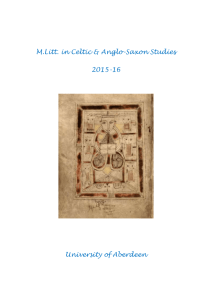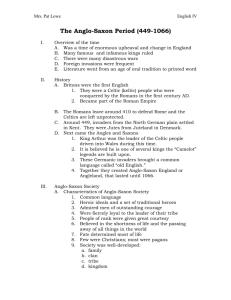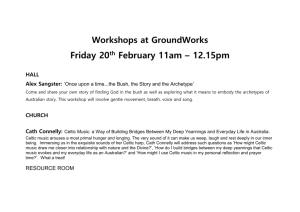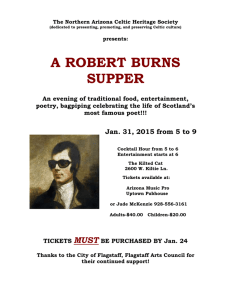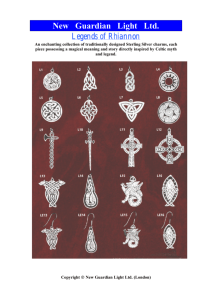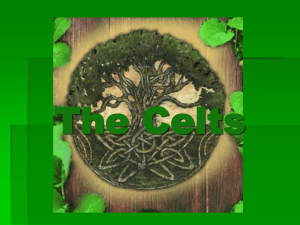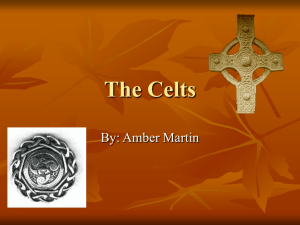Celtic & Anglo-Saxon Studies September 2013 University of
advertisement
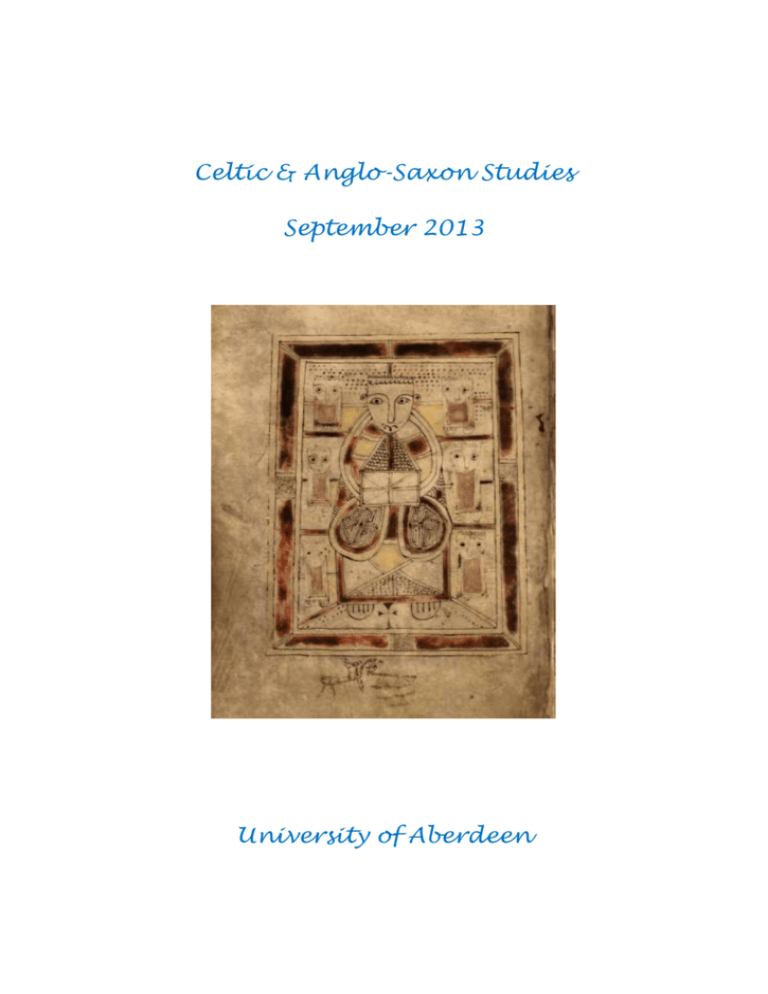
Celtic & Anglo-Saxon Studies September 2013 University of Aberdeen 2 M.A. in Celtic & Anglo-Saxon Studies I Introduction Celtic & Anglo-Saxon Studies is a new and innovative interdisciplinary programme. It will be available from September 2013 as a single-honours M.A.. or as part of a joint-M.A. degree with another subject, e.g. History, Archaeology, English, Linguistics, Scottish Gaelic or another modern language. (This programme, by teaching the languages, literatures and cultures of the Celtic and Anglo-Saxon worlds, replaces the previous Celtic Studies and Celtic Civilisation programmes.) The new programme is very flexible in regard to honours options. Each academic year, a minimum of two special subject courses in comparative literature, comparative historical study, or practical skills will be taught, depending on staff availability and student interest. This is in addition to the honours language teaching. NB For those studying for degrees in other subjects, but who are interested in learning more about Celtic and Anglo-Saxon literature, history and culture: You can still get ‘Sustained Study’ credit on your transcript for Celtic & Anglo-Saxon Studies courses, even if your degree is in something completely different! Just take one course per semester for the first two years of your degree. II Structure ‘Programme requirements’ below are based on those for single-honours students in Celtic & Anglo-Saxon Studies; for joint-honours requirements, divide by half. Level 1 Programme requirement of 30 credit points from courses considered to be part of the Celtic & Anglo-Saxon curriculum, plus 90 credit points from courses of choice agreed with Adviser of Studies 3 First half-session: ‘Barbarians, Romans, Gods and Warriors’ (15 credits) This course provides an introduction to the cultures of the Celtic and Germanic peoples who inhabited western and central Europe in the period of Classical Antiquity, their interactions with Graeco-Roman civilisation, 500BC-AD500, and their fates in the post-Roman world of the European early Middle Ages. Change over time will provide a major driver of the course: empire and its effect; the history and impact of the ‘barbarian’; the successive impacts of Roman religion and of Christianity, and the ways in which they were represented in the ‘heroic’ literature of the Middle Ages. Two one-hour lectures and one one-hour tutorial per week Assessment: one two-hour written examination (60%), an essay of approx. 2,000 words, including references but excluding bibliography (30%), and tutorial participation (10%) Second half-session: ‘Arthur and Finn, Beowulf and Alfred the Great: History, Law and Literature in the Early Mediaeval North’ (15 credits) This course will provide an introduction to the changing cultures of the early mediaeval North, especially as seen through the prism of interaction between the Germanic and Insular Celtic peoples. The course will be intercultural and interdisciplinary, designed to engage students with interests in language, law and/or literature. Two one-hour lectures and one one-hour tutorial per week Assessment: one two-hour written examination (60%), an essay of approx. 2,000 words, including references but excluding bibliography (30%), and tutorial participation (10%) Level 2 Programme requirement of 60 credit points from courses considered to be part of the Celtic & Anglo-Saxon curriculum, plus 60 credit points from courses of choice agreed with Adviser of Studies 4 First half-session: ‘Arthur in Mediaeval Celtic and Scandinavian Literature’ (15 credits) The course provides a survey of literature on Arthur in the Middle Ages, focusing on early Welsh and Gaelic sources, related Scandinavian literature and French, Welsh and English romances. It includes discussion of broader themes and questions posed by the literature, e.g. whether Arthur could have been a real person, how the Arthurian legend evolved over time and in different areas of Europe, and why the character has been elevated to iconic status. One one-hour lecture and one one-hour tutorial per week Assessment: one two-hour written examination (60%), an essay of approx. 2,000 words, including references but excluding bibliography (30%), and tutorial participation (10%) OR (in alternate years) ‘Vikings in Celtic and Germanic Scotland’ (15 credits) The Viking Age (A.D. 800-1100) was an era of vigorous economic and political change in western Europe. Scandinavian assaults and conquests changed many of the social norms of early mediaeval Europe, as did the development of urban culture and international trade associated with vikings’ activities. Vernacular literatures developed with outstanding results in the Insular zone, attested by fascinating texts in English, Gaelic, Scandinavian, and Welsh. Scotland provides in microcosm an intense realisation of all these trends; the subject-matter of this course is, therefore, particularly useful and locally appropriate. One one-hour lecture and one one-hour tutorial per week Assessment: one two-hour written examination (60%), an essay of approx. 2,000 words, including references but excluding bibliography (30%), and tutorial participation (10%) Second half-session: ‘The Celts, their Neighbours, and the Classical World’ (15 credits) Greek and Roman interactions with, and perceptions of, Celtic and Germanic peoples will form the central theme of this course. It includes in-depth discussion of migrations, material 5 cultures and pre-Christian belief-systems. We will also analyse individual Classical authors’ motives and judgments in relation to Celts and Germani, and how these perceptions evolved against the background of the emerging Roman Empire. In addition the course involves discussion of broader themes and questions posed by the sources, e.g. the portrayals of Celtic and Germanic peoples in Greek and Roman art, and the possible uses by Celtic and AngloSaxon literatures of Classical texts. One one-hour lecture and one one-hour tutorial per week Assessment: one two-hour written examination (60%), an essay of approx. 2,000 words, including references but excluding bibliography (30%), and tutorial participation (10%) OR (in alternate years) ‘Love, Loss and Revival: Gaelic Ireland, 1700 to the Present’ (15 credits) Detailed discussion of topics including the history of Gaelic Ireland from the eighteenth century onwards; and the aims and achievements of all genres of literature in modern Irish, eg. vision-poems and prose diaries. The course will also cover the major twentieth-century poets and their motivations, e.g. self-discovery, urban/rural tension and commentary on political and social aspects of their own day. One one-hour lecture and one one-hour tutorial per week Assessment: one two-hour written examination (60%), an essay of approx. 2,000 words, including references but excluding bibliography (30%), and tutorial participation (10%) Levels 3 & 4 (taught together) Programme requirement of 240 credits in all (courses 30 credits each): level 3 and 4 courses worth a total of 210 credit points from courses considered to be part of the Celtic & AngloSaxon curriculum, as agreed with Adviser of Studies, plus (for single-honors students only) 30 credit points in a different subject for Discipline Breadth. At least 90 credit points must be at level 4. Candidates at Level 3 and Level 4 must take at least one Language course or one Special Subject course in Celtic & Anglo-Saxon Studies per half-session. 6 First and second half-session: Language courses (no previous knowledge of Celtic languages is required) Introduction to Old Gaelic (30 credits) OR (in alternate years) Introduction to Brittonic Language (30 credits) – usually Medieval Welsh First and/or second half-session: Old English or Old Scandinavian Language (30 credits) - in alternate years First and second half-session: Special Subject courses At least one of these to be taught each half-session, and two (from different areas) to be taught in each academic year; teaching will be planned at least one year ahead, and will depend on student interest and staff availability. Students may take either an interdisciplinary or a specialist approach to these courses, i.e. no restrictions (except that obviously you cannot take the same course twice). Special Subject I – Comparative Literature ‘Tales of Vengeance and Enchantment: The Heroic Age in Irish and Icelandic Saga Literature’ (30 credits) Mediaeval Irish and Icelandic sagas represent the largest and most varied, and certainly the most entertaining, body of vernacular prose narrative in existence in early mediaeval Europe. They contain some of the North’s most distinctive and impressive contributions to world literature. Drawing on common oral and literary traditions from the North Atlantic cultural zone, these tales dramatize the legendary past by populating it with larger-than-life heroes whose deeds and misdeeds were felt to define the meaning of that past for mediaeval audiences. These two bodies of northern literature are usually studied in isolation, but this course will place them side by side. It will explore narratives ranging from heroic tales of cattle-raids and bloodfeuds to stories about the living dead and quests to the otherworlds of the Western and Arctic oceans. The tales will be analysed (in translation) from literary and historical perspectives. 7 One one-hour lecture and one two-hour seminar per week Assessment: one two-hour written examination (60%), an essay of approx. 2,000 words, including references but excluding bibliography (30%), and seminar participation (10%) OR ‘Dangerous Liaisons: Love, Sex and Romance in the Celtic West and the Old North’ (30 credits) The literature of the Celtic and Germanic Middle Ages is famous for its tragic tales of illstarred romance and forbidden love, as well as for the frankness and freshness with which its poetry explores the subject of sexual attraction. This course will explore how the interwoven themes of love, sex and romance were dramatized in Celtic, Norse and Anglo-Saxon stories and poetry. Topics covered will include some or all of the following: the love-triangle in Celtic and Norse narrative, maiden-kings and cross-dressing in Norse romance, amorous trolls, sexual insults, the stepmother as temptress, the bride as peace-weaver in heroic society, elopements and abductions, otherworldly lovers, lyrics of requited and unrequited love, and sexual humour. One one-hour lecture and one two-hour seminar per week Assessment: one two-hour written examination (60%), an essay of approx. 2,000 words, including references but excluding bibliography (30%), and seminar participation (10%) OR ‘Celtic Myth in the Modern World: From Ossian to the New Age’ (30 credits) This course examines how and why stories and images of a mythical Celtic past came to haunt the modern Western imagination, focusing in particular on Anglophone Britain and Ireland since c. 1760. The Celtic cultures in which these stories were originally produced suffered disastrous political setbacks in the early modern period; but these stories soon attracted much learned and popular interest outside the Celtic-speaking world. Here, sometimes transformed beyond recognition, they have served new purposes: literary, social, religious, political and musical. We will trace these metamorphoses by examining the forms and functions of Celtic legendary narrative in (for example) Romantic literature, art and 8 music; Scottish and Irish national revival movements; twentieth century Anglophone literature; and the New Age movement. One one-hour lecture and one two-hour seminar per week Assessment: one two-hour written examination (60%), an essay of approx. 2,000 words, including references but excluding bibliography (30%), and seminar participation (10%) Special Subject II – Practical Skills ‘Celtic and Anglo-Saxon Manuscript-studies’ (30 credits) This course provides an in-depth introduction to Insular script and Insular book-production. A distinctive sub-Roman polymorphous script-form and mode of book-production was created in Celtic Britain and Ireland in the fifth or sixth century; this has long since been named ‘Insular’. These forms gained remarkable European diffusion over succeeding centuries, being used at varying times as far afield as Italy and Scandinavia (and perhaps Ukraine!), particularly through the activities of English and Gaelic clergy. After about 1200, Insular script and book-production became purely Gaelic modes, albeit used for both vernacular and Latin writing. Printing in Irish extended over some four centuries from the later sixteenth century, in forms adapted from Insular script; this Gaelic type was used in Irish governmental publications from independence in 1921/2 until 1948, and ‘Irish’ (that is, Insular) script was taught in schools during the same period. In sum, this script-form had a life of about 1500 years and, at the height of its popularity, was a much more general European phenomenon. One one-hour lecture, one one-hour seminar, and two one-hour practical classes per week Assessment: one three-hour written examination (100%); formative practical class-exercises OR ‘Comparative Germanic Philology’ (30 credits) The introduction of the new Celtic & Anglo-Saxon Studies degree means that a new cohort of students informed in Old English will be likely to want to take a course which both gives their study of that language greater depth and introduces them to means by which they can 9 develop a sense of the comparative diversity and similarity of its sister languages. It is likely that students of both Scandinavian Studies and also Language and Linguistics students may be interested in this course. One two-hour language seminar and one one-hour informal lecture per week Assessment: Level 3 -- Two 2,000-2,500 word essays (35% each); one linguistic analysis (1,500-2000 words for both) of texts from two languages from a choice of four (20%); seminar performance (10%) Level 4 -- Two 2,500-3,000 word essays (35% each); one linguistic analysis (750 words for each) of texts from three languages from a choice of four (20%); seminar performance (10%) Special Subject III -- Comparative Historical Study ‘Celtic and Anglo-Saxon Kingship and the Exercise of Authority in the Earlier Middle Ages’ (30 credits) At the end of Antiquity and the beginning of the Middle Ages, Celtic and Germanic kingship had a perhaps superficial structural similarity. however. Germanic kingship had shallow roots, Celtic kingship, on the other hand, enjoyed a very long history and solidly established foundations. The post-colonial situation in Britain (and more generally in western Europe at large) brought great change. Christianity offered new (Jewish and Roman) methods of rulership. For the Gaelic world, on the other hand, in conjunction with a largely peaceful receipt of Christianity, continuity is the watchword. Both practice and theory of kingship in a changing world are abundantly attested in a rich variety of sources, documentary, linguistic, literary, and material: full advantage will be taken of these resources, with close attention given to the intercultural and interdisciplinary study of primary sources. One one-hour lecture, one one-hour sources class, and one one-hour seminar per week Assessment: one two-hour written examination (60%), an essay of approx. 2,000 words, including references but excluding bibliography (30%), and seminar participation (10%) OR 10 ‘Law and Literature among the Celts and Anglo-Saxons in the Early and Central Middle Ages’ (30 credits) A rich legal literature, at once ecclesiastical and secular, descriptive and prescriptive, has survived from both England and the Celtic-speaking countries from the late sixth/early seventh century to the twelfth. Almost by definition, this literature deals with almost every aspect of earlier mediaeval society. It is complemented by narrative and poetic literature which dwells, both by precept and by providing exemplars, on the ideal and the undesirable aspects of human nature and society. This course is devoted both to legal thought and to law operative in society, in both Celtic-speaking and English-speaking countries. One one-hour lecture, one one-hour sources class, and one one-hour seminar per week Assessment: one two-hour written examination (60%), an essay of approx. 2,000 words, including references but excluding bibliography (30%), and seminar participation (10%) Celts and Anglo-Saxon Studies Dissertation (30 credits) Compulsory for single-honours students in fourth year; joint-honours students write a dissertation in one or other of their subjects: your choice!) For further information, please contact the Programme Co-ordinator, Dr Aideen M. O’Leary – a.oleary@abdn.ac.uk, or (01224) 273100 Cover image: St John from the ‘Book of Deer’, a Gospel book with connections to the NorthEast of Scotland, generally dated to the tenth century: Cambridge, University Library, MS. Ii.6.32, fo, 41v Copyright: Cambridge University Library
